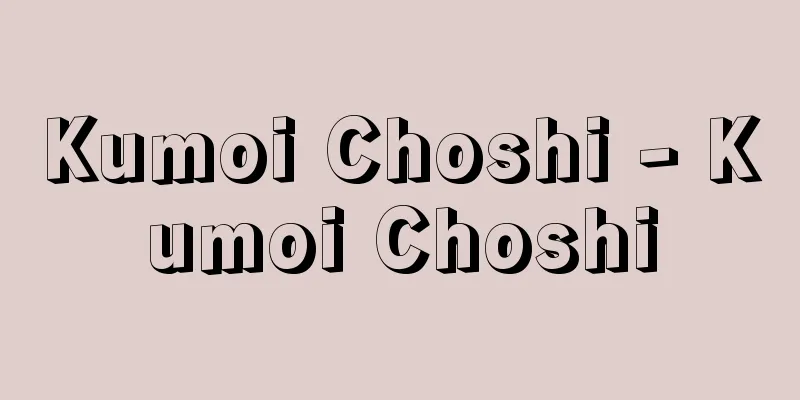Korean Theatre

|
Korean theatre can be broadly divided into traditional theatre (classical theatre) and modern theatre, with traditional theatre being divided into two categories: court theatre and folk theatre, while modern theatre is diverse and includes new theatre, light theatre, and musical and dance theatre. [Kim Ryoki] From the Three Han Dynasty to SillaKorean traditional theater has a particularly strong element of song and dance, and overlaps with the history of Korean music and dance. During the Three Han period before Christ, there were rituals to worship the heavens, such as the Cheonjun (Heavenly King) of Mahan, Mucheon (Mujiyon) of Wi, and Yonggo (Yeonggo) of Buyeo, in which people sang, danced, and drank alcohol to worship the heavens. Similar ceremonies were also held in Byeonhan and Jinhan. These were shamanistic religious rites to pre-celebrate and pray for abundant grain. The content includes myths such as the ancestor of the Garak Kingdom (Daegaya) descending to Guji Peak, in which the heavenly gods and humans exchange the divine song "Guijiga," and we can see a primitive form of theater. The murals of early tombs from Goguryeo (c. 37 BC - 668 AD) (Dance Tomb in Ji'an, Jilin Province, China, Angaku Tomb, and Hakseong-ri Tomb) depict group dances, musical instruments, masked dances, and other forms of art. In Baekje (? - 660), there were songs and dances such as gigaku, Nokjunogi, Mudeungsan, and Jeongeup, but only the music of Jeongeup remains today. It is recorded in the Nihon Shoki that the Baekje monk Mimasashi introduced gigaku from Wu to Japan, and there is a theory that today's Sandae-nori is a relic of that gigaku. Clay figurines from Old Silla (57 BC - 668 AD) feature images of people singing, dancing and playing music, and similar designs can be found on pottery. At the time, local folk music (hyangak) and foreign music were popular, and the Hwarang (Hwarang), an organization of young warriors who were loyal to the emperor and patriotic and who formed the foundation of Unified Silla (668-935), studied literature and the arts as well as martial arts. After the establishment of a unified nation, the Hwarang movement rapidly leaned towards elegance and took up the path of the arts. Entertainers are commonly called Hwarang, and Hwarang's influence on the performing arts was great. In Unified Silla, various performing arts flourished, such as the Sword Dance (Kuo-omum), a memorial dance for the Hwarang (Hwangchi-yang) who died in battle, the Mu-eum (Muemu) danced by the great priest Wonhyo to spread Buddhism, and the Gaui (Gai-hai) on August 15th, in which women competed in hemp spinning and the losers entertained the winners with singing, dancing, and drinking. In addition, there were masked dances of the perverse Jin-gyeong, such as Cheo-yong-mu (Cheo-yong-mu), named after the prince of the Dragon King of the East Sea, and San-yo-omum (Mountain God Dance), which is said to have been danced by the mountain god of Namsan Mountain in Gyeongju before the king, and Sangaku (Sangaku) and Gigaku (Gigaku) from the continent were performed on the streets. There is also the Goki, which is said to be of Western origin, and these are Kumhuan (Rogan), Woljiyon, Daemiyon (mask), Sokkutoku, and Sanae (lion dance). [Kim Ryoki] Goryeo DynastyThe Goryeo dynasty (918-1392) made Buddhism its state religion, and held the Yongdonghue Festival in spring to pay tribute to Buddha, and the Pakwanhue Festival in winter to pay tribute to local gods. These were national events centered around the king, and traditional Chinese music such as Tabsahaeng and Wangmo-dae song and dance were performed alongside it. Female music was performed by shamans, giving birth to the later official performance of kisaeng. Cheoyongmu and hyakubutsu were also performed at the Narye Festival, a New Year's Eve ritual. Masked plays and zaju were also performed on a five-colored stage called the Sandae, and it is said that Sandae opera originated from there. In the streets, professional entertainers called Kwandae or Jieiin performed many shows, such as Dongdong and Muko. Yangsujeok (also called Huacheok, Sucheok, or Baekjiyeon), who were mainly nomads from the mainland, were skilled in butchering livestock and willow crafts, while the women sold their skills and prostitution. It is believed that they traveled to Japan and became puppets. [Kim Ryoki] Yi DynastyDuring the Yi Dynasty (1392-1910), these wanderers organized themselves into groups called Sadang (temple/sageang) pae, toured the country, and spread their wandering arts. Their repertoire was centered on the puppet show Gokdugaksnormu (also called Park Ji-gyeo), but also included masked plays, farmer's music (Nongak), tug-of-war, plate spinning, and other diverse arts. Today's Namsadang is a descendant of this. At the time, pansori, an oral art form originating in Jeolla Province, was very popular and was performed by performers. In the late 19th century, Shin Jae-hyo reorganized it into a theatrical form. Also, in the late 19th century, influenced by Chinese Peking Opera, pansori formed a national theater called Changgeuk. Changgeuk is an opera in which one person plays one role that developed from pansori, in which one person plays all roles. Currently, in South Korea (Republic of Korea), it is inherited and nurtured by the National Drama Company, and in North Korea, it is performed as a national opera. There are no tragedies in traditional Korean theater. Although tragedies are often used in the plays, they end up with happy endings, making them comedies. This can be said to be a major characteristic. [Kim Ryoki] New TheatreIn 1902, the first theater in Korea, the National Theater, Hyeopyusa, was founded, and at the end of the same year, it performed "Seochiundae Yugi". Hyeopyusa performed many plays such as changgeuk, pansori, and gisaeng dance, but in 1908, the management was handed over to the private sector, and Lee In-jik's "Silver World" was performed. This was a new-school style play influenced by Japanese warrior plays, and such plays continued for a while. Towolhue was a theater company formed by students studying in Tokyo, and its visit to Korea in 1922 marked the birth of full-scale new theater in Korea. The leader Park Seung-hee's "Kilsik" and Chekhov's "The Bear" were box office failures, but the following year Tolstoy's "Resurrection" was a huge success. In 1923, Song Young founded the Yeomgunsa Society, which launched a left-wing theater movement with the slogan "Research and Movement for Proletarian Liberation Culture." In 1925, this evolved into the Korean Proletarian Arts Alliance (KAP), and in the 1930s, the Shinkensetsu Association was founded in Seoul, and the March 1st Theater and Korean Art Theatre were founded in Tokyo, both of which came under its umbrella. The Dowol Society later split into a commercial theater faction and a pure theater faction, and with the addition of left-wing theater, the theater world split into three trends. Many Korean theater people were pressured to take part in Japan's national theater, but refused. Liberation came on August 15, 1945, and the Proletarian Theater League was formed in Seoul that same year. In 1947, two plays, "Taebaek Mountains" by Ham Se-deok and "With Great Love" by Cho Young-chu, were performed in Seoul as a joint performance by various theater companies, attracting a record audience of 160,000 people over 16 days. In the same year, Ryu Chi-jin, a standard-bearer of naturalistic realism since before the war, broke his long silence and began to enthusiastically present and perform new works, including "Ji Myung Go." He and Lee Se-gu founded the "National Theater Arts Association," which later developed into the "National Federation of Cultural Organizations," and this marked the beginning of a conflict between the two major theater styles, the left-wing theater of the former and the pure theater of the latter. In 1948, South Korea was established in the south and North Korea was established in the north, and after the Korean War armistice in 1953, theater movements developed in both the south and the north. [Kim Ryoki] north koreaNorth Korea is developing a theatrical movement on a socialist national level, centered around the National Theatre and Provincial Theatres. In the latter half of the 1950s, playwright Song Young and people's actor Hwang Cheol created socialist realist plays such as "The Wolf" and "The Story of the Yangban." Around the 1970s, based on the ideology of Chairman Kim Il Sung's Juche (subjectivity), the "Sea of Blood" style was born, recreating the traditions of anti-Japanese partisans, such as "The Girl Who Sells Flowers," "The City Godang," and "Sea of Blood," and these large-scale revolutionary operas are currently in their heyday. [Kim Ryoki] South KoreaKorean original dramas tend to pursue naturalistic realism, and are limited to works from the liberal camp; leftist dramas and Japanese works are not performed. After a period of reconstruction in the 1950s, young theater artists were nurtured during the 1960s and 1970s, when Cha Beom-seok's "Forest Fire" was released and became a hot topic. In 1973, the National Theater opened with modern facilities, and began a wide range of activities with the goal of creating ethnic theater. In the 1980s, the small theater movement by young theater artists and the Madang (square, courtyard) drama movement, which incorporated traditional performance forms, rapidly grew, and experimental attempts such as the revival and re-creation of classic changgeuk were also active. During that time, the National Theater Company of Korea and over 30 other specialized theater companies were active, supported by the Korea (Republic of Korea) Theater Festival, the Dong-A Ilbo Theater Award, and the Hankook Ilbo Theater and Film Award. [Kim Ryoki] "Outline of the History of Korean Theater" by Han Hyao (1956, Pyongyang, National Publishing House) " ▽ "History of Korean Theater" by Du Hyun (1973, Seoul, People's Library) ▽ "Korean Performing Arts" by Kim Ryong-ki (1976, Iwasaki Bijutsusha) ▽ "The World of Korean Mask Theater" by Kim Ryong-ki (1987, Shinjinbutsu Oraisha) [References] | | | | | | |Source: Shogakukan Encyclopedia Nipponica About Encyclopedia Nipponica Information | Legend |
|
朝鮮の演劇は伝統演劇(古典劇)と現代演劇とに大別され、伝統演劇は宮廷と民間の二つに分けられる。現代演劇は新劇、軽演劇、歌舞劇など多岐にわたっている。 [金 両 基] 三韓時代から新羅まで朝鮮の伝統演劇はとりわけ歌舞の要素が強く、朝鮮の音楽や舞踊の歴史と重なり合う。紀元前の三韓(さんかん)時代には、馬韓(ばかん)の天君(チヨングン)、濊(わい)の舞天(ムチヨン)、夫余(ふよ)の迎鼓(ヨンゴ)など、歌舞飲酒して天を祭る祭天儀式が行われ、弁韓(べんかん)や辰韓(しんかん)でも同種の儀式が行われた。これらは五穀豊饒(ほうじょう)の予祝や祈願のシャーマニズム神事であった。内容は、駕洛(からく)国(大伽倻(かや))の始祖が亀旨峰に天下る神話などで、天神と人間が神歌の「亀旨歌(クイジガ)」を歌い交わすというような、原初的演劇形態がうかがえる。 高句麗(こうくり)(前37ころ~後668)の初期の古墳壁画(中国吉林(きつりん)省集安の舞踊塚、安岳(あんがく)古墳、八清里古墳)に、群舞、奏楽、仮面舞などが描かれており、形の整った芸態がうかがえる。百済(くだら)(?~660)には伎楽(ぎがく)や弄珠之戯(ろうちゅのぎ)、無等山(ムドウンサン)、井邑(ジヨンウブ)などの歌舞があったが、現在は井邑の音楽だけが伝わる。百済の僧味摩之(みまし)が呉(くれ)の伎楽を日本に伝えたことは『日本書紀』に記されているが、今日の山台劇(さんだいげき)(サンデノリ)がその伎楽の遺風だとする説がある。 古新羅(しんら)(前57~後668)の土偶に歌舞奏楽の像があり、土器にもその類(たぐい)の絵柄がある。そのころ民族楽系の郷楽(ヒァンアク)と外来楽が流行し、統一新羅(668~935)の礎(いしずえ)となった忠君愛国の青少年戦士の組織であった花郎(かろう)(ファラン)たちは、武とともに文・芸をも学んだ。その花郎道は統一国家を樹立し遂げたあと、急速に風流に傾斜し、芸道の道に走った。俗に、芸人を花郎とよぶように、花郎道の芸能に与えた影響は大きい。統一新羅では、戦死した花郎の黄倡(フアンチヤン)(官倡(クワンチヤン)ともいう)の追悼舞である剣舞(クウオムム)、元暁(げんぎょう)大師が仏教の布教のために舞った無舞(ムエム)、婦女たちが麻紡ぎを競い合って負け組が歌舞飲酒でもてなした8月15日の嘉俳(カウイ)など多彩な芸能が栄えた。さらに、東海の竜王の王子にちなむ処容舞(チヨヨンム)、慶州の南山の山神が王の御前で舞ったという霜髯舞(サンヨオムム)(山神舞)などの僻邪進慶(へきじゃしんけい)の仮面舞があり、巷間(こうかん)では大陸からの散楽(さんがく)や伎楽が演じられていた。また、西域(せいいき)系の伎楽とされる五伎があるが、五伎とは金丸(クムフアン)(弄丸(ろうがん))、月顛(ウオルジヨン)、大面(テミヨン)(仮面)、束毒(ソクトク)、狻猊(サネ)(獅子(しし)舞)のことをいう。 [金 両 基] 高麗時代高麗(こうらい)(918~1392)は仏教を国教とし、春には燃灯会(ヨンドンフエ)を開いて仏を、冬には八関会(パルクワンフエ)を開いて土俗神を供養する祭祀(さいし)を行った。これらは王を中心とした国家的行事で、郷楽と踏沙行(タブサヘン)や王母隊(ワンモデ)歌舞のような唐楽(とうがく)が併演され、そのとき巫堂(ムーダン)による女楽を演奏し、後の官伎(妓生(キーセン))を生んだ。大晦日(おおみそか)の追儺(ついな)行事である儺礼(ナレ)には、処容舞や歌舞百戯が併演された。また、五色に彩られた山台(サンデ)と称する舞台で仮面劇や雑劇が演じられ、そこから山台劇が始まったとされる。巷間では、広大(クワンデ)や才人(ジエイン)と称する職業芸人が動動(ドンドン)や舞鼓(ムコ)など、多くの見せ物芸を演じていた。また、大陸からの漂泊民を主とする楊水尺(ヤンスチョク)(禾尺(フワチヨク)や水尺(スチヨク)、白丁(ペクチヨン)ともいう)の男たちは畜殺や柳細工に長(た)け、女は芸や春を売った。彼らが日本に渡って傀儡(くぐつ)になったと考えられる。 [金 両 基] 李朝時代李朝(りちょう)(1392~1910)になると、これらの漂泊民はサダン(寺党・社党)牌(ペ)という集団を組織して全国を巡演し、放浪芸を広めた。彼らのレパートリーはコクトゥ閣氏(カクシ)ノルム(朴僉知劇(パクチヨムジノルム)ともいう)という人形劇を中心に、トッペギ(仮面劇)、農楽(のうがく)(ノンアク)の風物(プンムル)、チゥルタリギ(綱引)、皿回しなど多彩であった。今日の男寺党(ナムサダン)はその流れをくんでいる。当時、全羅道を発祥地とする口承芸能のパンソリの人気が高く、広大(芸人)によって演唱されていた。それを19世紀後半に申在孝が演劇的に整理再編した。また、19世紀末葉には中国の京劇の影響を受けて、パンソリは唱劇(しょうげき)(チャンクク)という民族演劇を形成した。唱劇は一人全役のパンソリから発展した一人一役形態の歌劇で、現在韓国(大韓民国)では国立国劇団が継承、育成し、北朝鮮では民族オペラとして上演されている。朝鮮の伝統演劇には悲劇が存在しない。劇中では悲劇を多用するが結末はハッピーエンドで、喜劇になってしまう。それは大きな特徴といってよい。 [金 両 基] 新しい演劇1902年、朝鮮最初の劇場である国立劇場の協律社(ヒヨブユルサ)が創建され、同年末『笑春臺遊戯(ソチウンデユフイ)』を上演した。協律社では唱劇、パンソリ、妓生舞踊などが多く上演されたが、08年には運営が民間にゆだねられ、李人稙(りじんちょく)の『銀世界(ウンセゲ)』が上演された。これは日本の壮士芝居の影響を受けた新派調の芝居であり、しばらくはそのような芝居が続いた。土月会(トウオルフエ)は東京の留学生が組織した劇団で、22年の母国訪問公演が朝鮮の本格的な新劇の産声となった。リーダー役の朴勝喜(ぼくしょうき)の『吉植(キルシク)』、チェーホフの『熊』の上演は興行的に失敗したが、翌年トルストイの『復活』が大成功を収めた。 1923年、宋影(そうえい)を中心とする焔群社(ヨオムグンサ)が生まれ、「無産階級解放文化の研究と運動」をスローガンに掲げた左翼演劇運動が始動、25年「朝鮮プロレタリア芸術同盟」(カップ)へと発展、30年代にはソウルに「新建設」、東京に「三・一劇場」「朝鮮芸術座」が結成されてその傘下に入る。土月会はのちに商業演劇派と純粋派とに分かれ、それに左翼演劇が加わって演劇界は三つの傾向に分かれた。なお、多くの朝鮮の演劇人は、日本の国民演劇への参加を強要されながらも、それを拒んだ。 1945年8月15日の解放を迎え、その年プロレタリア演劇同盟がソウルで結成された。47年、咸世徳(かんせいとく)の『太白(たいはく)山脈』と趙霊出(ちょうれいしゅつ)の『偉大なる愛をもって』の2作を各劇団の合同公演としてソウルで上演し、16日間で16万人という記録的動員を達成した。同年、戦前からの自然主義リアリズムの旗手であった柳致真(りゅうちしん)が長い沈黙を破って『自鳴鼓(ジアミヨオンゴ)』をはじめ意欲的に新作を発表し上演する。彼は李瑞求(りずいきゅう)と「全国演劇芸術協会」を創立し、のちに「全国文化団体聯合(れんごう)会」へと発展、ここに前者の左翼演劇と後者の純粋演劇の左右二大演劇の葛藤(かっとう)が始まった。そして48年には南に韓国が、北に北朝鮮が樹立され、53年の朝鮮戦争休戦後は、南と北とでそれぞれに演劇運動が展開されていく。 [金 両 基] 北朝鮮北朝鮮では国立劇場や道立劇場を中心に、社会主義国家的次元の演劇運動を展開している。1950年代の後半は劇作家の宋影、人民俳優の黄澈(こうてつ)などを中心に『狼(おおかみ)』『両班(ヤンバン)伝』などの社会主義リアリズム演劇を創造した。70年前後から金日成主席のチュチェ(主体)思想に基づき、『花を売る乙女』『城隍堂(ソナンダン)』『血の海』など、抗日パルチザンの伝統を再創造した「血の海方式」が生まれ、現在これら大規模な革命歌劇の全盛期にある。 [金 両 基] 韓国韓国の創作戯曲は自然主義リアリズムを追求するものが多く、自由主義陣営の作品に限られ、左翼演劇と日本の作品は上演されていない。1950年代の再建期を経て、60年から70年の中興期に若い演劇人が育ち、車凡錫(しゃぼんしゃく)の『山火事』が発表され話題になった。73年には近代設備を整えた国立劇場が新開場し、民族演劇の創造を課題として幅広い活動を始めた。80年代には若い演劇人による小劇場運動と、伝統的上演形態を取り入れたマダン(広場、庭)劇運動が急速に高まり、唱劇の古典の復活と再創造などの実験的試みも盛んである。その間、韓国(大韓民国)演劇祭、東亜日報演劇賞、韓国日報演劇映画賞などの支援に支えられて国立劇団ほか30余の専門劇団が活動している。 [金 両 基] 『韓暁著『朝鮮演劇史概要』(1956・平壌・国立出版社)』▽『杜鉉著『韓国演劇史』(1973・ソウル・民衆図書館)』▽『金両基著『朝鮮の芸能』(1976・岩崎美術社)』▽『金両基著『韓国仮面劇の世界』(1987・新人物往来社)』 [参照項目] | | | | | | |出典 小学館 日本大百科全書(ニッポニカ)日本大百科全書(ニッポニカ)について 情報 | 凡例 |
>>: Datura stramonium - Datura stramonium
Recommend
Kyogen short song - Kyogen Kota
Short songs sung in Noh and Kyogen. The songs them...
Bronchial breath sounds
… Breath sounds are similar to white noise (the h...
Airtight Silo - Kimitsu Sairo
…Small semi-underground silos, common in Japan, a...
destrudo
… He recognized the opposition between the two gr...
Joseph Achille Le Bel
1847‐1930 French chemist. Born in Pécherbronn, Als...
Cyperus serrata - Cyperus serrata
An annual plant of the Cyperaceae family (APG cla...
Ayer, C.
…In the event of an emergency, we will form allia...
Scarecrow - Scarecrow
A device or equipment used to scare away birds and...
Dura Europos (English spelling)
The ruins of an ancient city on the right bank of ...
Ginzburg, ES (English spelling)
…He has been actively publishing his avant-garde ...
Nelson, E.
... The above-mentioned method of using model the...
Foreign Investment
…When speculators judge that the exchange rate wi...
Rotating snow shovel - Rotating snow shovel
...railroad vehicles used for clearing snow from ...
Hilferding
German economist and politician born in Vienna. Ge...
Carex lenta (English spelling)
…[Tetsuo Koyama]. … *Some of the terminology expl...









